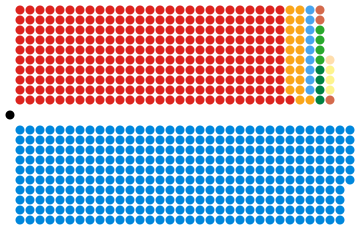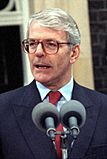1992 United Kingdom general election facts for kids
|
|||||||||||||||||||||||||||||||||||||||||||||
|
|
|||||||||||||||||||||||||||||||||||||||||||||
|
All 651 seats in the House of Commons 326 seats needed for a majority |
|||||||||||||||||||||||||||||||||||||||||||||
|---|---|---|---|---|---|---|---|---|---|---|---|---|---|---|---|---|---|---|---|---|---|---|---|---|---|---|---|---|---|---|---|---|---|---|---|---|---|---|---|---|---|---|---|---|---|
| Opinion polls | |||||||||||||||||||||||||||||||||||||||||||||
| Turnout | 77.7% ( |
||||||||||||||||||||||||||||||||||||||||||||
|
|||||||||||||||||||||||||||||||||||||||||||||

Colours show the winning party, as shown in the main table of results
|
|||||||||||||||||||||||||||||||||||||||||||||

Composition of the House of Commons after the election
|
|||||||||||||||||||||||||||||||||||||||||||||
|
|||||||||||||||||||||||||||||||||||||||||||||
The 1992 United Kingdom general election happened on 9 April 1992. People across the UK voted to choose their representatives. These representatives would sit in the House of Commons. This is an important part of the UK Parliament.
The Conservative Party won the election. Their leader, John Major, remained the Prime Minister. Many people were surprised by this result. Before the election, opinion polls had suggested that the Labour Party would win.
Contents
Understanding the 1992 UK Election
A general election is when people vote for who they want to represent them. In the UK, these representatives are called Members of Parliament (MPs). They work in the House of Commons. The party that wins the most seats usually forms the government. Their leader becomes the Prime Minister.
Who Could Vote in 1992?
In 1992, anyone aged 18 or over who was a British citizen could vote. They also had to be registered to vote. This election had a high turnout. About 77.7% of people who could vote did so.
The Main Political Parties and Their Leaders
Several political parties took part in the 1992 election. The three biggest parties were the Conservatives, Labour, and the Liberal Democrats.
The Conservative Party
The Conservative Party was led by John Major. He had become Prime Minister in 1990. The Conservatives had been in power since 1979. They wanted to continue their policies.
The Labour Party
The Labour Party was led by Neil Kinnock. They hoped to win the election and form a new government. Labour focused on improving public services. They also wanted to reduce unemployment.
The Liberal Democrats
The Liberal Democrats were led by Paddy Ashdown. This party was formed in 1988. They aimed to offer a different choice from the two main parties. They focused on social justice and environmental issues.
The Election Campaign
The election campaign lasted several weeks. Party leaders traveled around the country. They gave speeches and met voters. Each party tried to convince people to vote for them. Television debates and news coverage were very important.
Opinion Polls and Predictions
Before the election, many opinion polls were conducted. These polls asked people who they planned to vote for. Most polls suggested that the Labour Party would win. Some even predicted a clear Labour victory. This made the actual result a big surprise.
The Election Results
On 9 April 1992, people cast their votes. The votes were counted overnight. The results showed that the Conservative Party had won the most seats.
- Conservative Party: 336 seats
- Labour Party: 271 seats
- Liberal Democrats: 20 seats
The Conservatives won enough seats to form a government. John Major remained Prime Minister. This result was unexpected by many. It showed that opinion polls are not always correct.
Images for kids
-
Labour Leader Neil Kinnock conceding defeat
See also
 In Spanish: Elecciones generales del Reino Unido de 1992 para niños
In Spanish: Elecciones generales del Reino Unido de 1992 para niños






